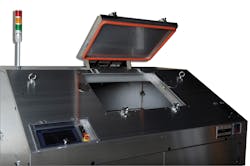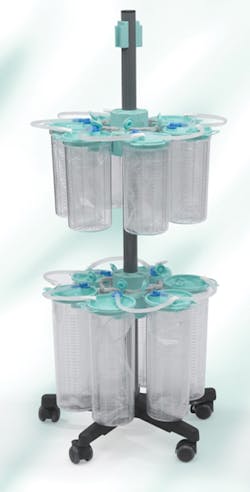According to Practice Greenhealth, hospitals and health systems produce 12,800 tons of waste each day.1 The areas of waste in healthcare are broad — from medical and pharmaceutical waste to wasted food and paper products — and they have far-reaching consequences. There is the obvious impact on the environment, including contamination of soil, water and air. Then there is the financial impact associated with waste disposal, whether it takes place onsite at the hospital or offsite through a third party service.
In this article, we report on ways to reduce and manage the variety of healthcare waste streams in a cost-effective manner. We include tips from industry experts, and new products aimed at reducing healthcare waste.
Balancing moral responsibility with reality
The American Hospital Association’s Sustainability Roadmap for Hospitals notes that non-regulated waste makes up approximately 85 percent of a hospital’s total waste stream. The organization points out that this category of waste is “no different from the waste generated by a hotel, where up to 60 percent is either recyclable or compostable.”2
Fiona Nemetz, MS, CHESP, Director, EVS, Safety and Security at Northside Hospital in Atlanta, feels it is healthcare’s “moral responsibility” to participate in as much recycling as possible but notes there are operational hurdles that must be overcome.
“A lot of people go into recycling with ambitious goals, but back up a little when they start realizing how much it entails,” said Nemetz. “For example, recycling is easier if you are in rural America, and you have all the space in the world and can put stuff in a trailer away from the hospital. But I work in Atlanta, and like most cities, every square inch is high commodity real estate.”
Nemetz urges healthcare facilities to first understand the regulations in their states for waste hauling before embarking on a new waste management initiative. Next, they must understand what can be classified as a solid waste versus medical waste. Waste products that have touched the patient typically cannot be included in a robust recycling program.
“Trace chemo cannot be processed on-site with an autoclave. It must be hauled off-site to be incinerated,” said Nemetz. “But there are some states where pathological waste can be processed in an autoclave. Get to know your state regulations. While you are learning your state regulations, become familiar with landfill requirements, which vary from state to state. Standards are much more stringent in the Northeast than they are in the South.”
Nemetz encourages those interested in launching waste management initiatives to create a collaborative team where they can flush out the decisions of what will be processed internally versus what will be contracted out.
“It is important to get all stakeholders to buy in – you may think you can recycle the plastics that come out of surgery then the surgery director says you can’t because they are contaminated with blood,” said Nemetz. “You must take a participative approach when you start branching out into different waste management areas.”
Controlled substances
Managing controlled substances is a new waste stream for most hospitals, according to Gerry van Domelen, Senior Manager of Rx Waste Compliance at Stericycle. He points out how diversion of these substances (historically flushed) is difficult to detect due to numerous medication-access points in hospital distribution systems.
Indiana University Health North implemented Stericycle’s CsRx System to help with its controlled substance waste stream. CsRx is Stericycle’s safe and secure solution for facilities that lack formal processes for the proper disposal of controlled substance waste. It is a comprehensive, yet simple ship-back system for disposing of tablets, capsules, pills, liquids and patches.
“We have a sense of comfort that controlled substances are not retrievable with the CsRx System,” said Janice Vadas, In-Patient Pharmacy Manager at IU Health North. “It helps keep controlled substances out of the water system and helps minimize risk. Diversion by employees can impair them and put patients at risk. A simple system means less can go wrong when managing this type of complexity.”
“The system improves the waste stream disposal processes, as an alternative to flushing, and to gain a more sustainable way to prevent diversion opportunities by employees,” added van Domelen.
Food
According to the Environmental Protection Agency (EPA), U.S. hospitals generate about 170,000 tons of food waste annually, making it a prime target for waste reduction.
“Food waste is a problem that is impacting the entire healthcare industry,” said Frank E. Celli, CEO of BioHiTech Global. “We are starting to hear from more and more hospitals across the country as they look to weave technology and data into their efforts to manage their wasted food.”
Celli describes how hospitals throughout the U.S. are using BioHiTech’s Eco-Safe Digester to measure patient waste, lower disposal costs, increase performance and efficiency, improve safety, and track the success of sustainability programs. He pointed to a New Jersey hospital that has used the Eco-Safe Digester to divert 120 tons of food waste from landfills annually, thereby slashing its waste disposal budget by 50 percent.
Earlier in 2016, BioHiTech launched a mobile app called BioHiTech Cirrus. Expanding on existing technology deployed by the company, the mobile app delivers improved accessibility and transparency to real-time food waste data, creating immediate opportunities to reduce and prevent the creation of waste.
A Practice Greenhealth case study describes the work Gundersen Health System in La Crosse, WI has done to reduce its food waste. In 2010, the health system conducted an analysis of its food waste using the LeanPath Tracker (automated scale and touch-screen terminal) in its kitchen and determined it was throwing out an average of half a ton of food each week, approximately 24 tons every year.
Staff then made changes to vegetable preparation to encourage less scrap waste, started heating soup in smaller portions and made many other simple changes that had a dramatic impact on food waste reduction. In just seven months (July 2010 to February 2011), Gundersen reduced its pre-consumer food waste by more than 50 percent by weight, saving $25,000 a year in diverted food purchases. From 2010 through 2015, they reduced food waste more than 80 percent from baseline, saving more than $30,000 a year.
Plastics
The Healthcare Plastics Recycling Council (HPRC) revealed that 20 and 25 percent of the 14,000 tons of medical waste generated by healthcare facilities in the United States each day is comprised of plastic packaging and plastic products.3
In the OR
“The need to supply a broad range of sterile products to the OR has created challenges for facilities looking to implement stronger green initiatives to reduce the environmental impact of healthcare,” said Shaun Sweeney, VP of Sales and Marketing, Cygnus Medical.
Whether cleaning, disinfecting or sterilizing reusable items or disposing of plastics in landfills or incineration, preventing the affects of infectious microbes comes with a significant “carbon footprint.”
In the fourth quarter of 2016, Cygnus Medical will be releasing the first biodegradable utensils designed for use in the operating theatre. This line of biodegradable single use instrument transport trays, bowls, basins and trays are made from renewable resources.
According to Sweeney, Single Cycle pulp products are very unique in that they are compatible and validated for use with steam sterilization, EtO and gamma. They have also been successfully tested against the most commonly used solutions and compounds found in the OR including:
- Chlorhexadine
- Alcohol wipes and gels
- Artificial blood
- Heparin
- Surfactants in gel, foam or liquid form
- Betadine
“By introducing products that maintain the highest levels of efficacy with limited negative impact to the environment, we can start to reduce the percentage of plastics found in medical waste,” Sweeney added.
Jason Pfeiffer, U.S. Sales Manager, Serres, a suction bag system manufacturer, says there is a growing demand from hospital ORs for eco-friendly products that are more efficiently designed, compact, and will reduce plastic waste. “These systems use durable, re-usable components with innovative disposal pieces to reduce overall waste while controlling costs at the same time,” said Pfeiffer. “With this type of system, you simply dispose what you use and replace accordingly. These products are also efficiently packaged which allows more product to be stored in the hospital and less frequent shipments needed, which has many other benefits.”
Large medical institutions face many challenges associated with waste reduction generated by the OR departments. Massachusetts General Hospital, which can typically generate upwards of 40,000-plus pounds of plastic medical waste annually on OR suction and fluid collection products alone, now uses the Serres Suction systems in all OR procedures. According to the company, Serres liquid handling systems are significantly more eco-friendly and efficient than competing products on the market and can drastically reduce this waste by up to 80 percent while offering safety, reliability and innovation.
Bottles and cans
Nemetz describes some of the challenges healthcare facilities face when recycling plastic bottles and aluminum cans. She explains that if the facility places segregated containers in each department where staff can dispose of the waste, then it will likely require additional full time employee resources to collect it. She says another option is to use a central repository in the cafeteria or in a break room.
“Either way, plastic bottles and aluminum cans get tricky because unfortunately you have to collect enough to make it financially viable for someone to come pick them up,” said Nemetz. “Another issue is that you have all the syrup that sits in the bottom of cans and bottles and that can become a hazard from a pest perspective.”
Janet Howard, Director, Member Engagement, Director, Healthier Hospitals, Practice Greenhealth, provides some alternatives to plastic water bottles that healthcare facilities can implement to reduce this waste.
“Hospitals are looking to reduce the amount of bottled water that is used both in catering and in the cafeteria,” said Howard. “Those that have successfully reduced the sale of bottled water may choose filtered water and either sell or give out reusable water bottles to staff to both educate and reduce this waste. In catering, bottled water can be replaced with pitchers of water infused with fresh fruit. Other innovative strategies include reusing coolers that were used for product delivery.”
Paper
Another important waste management endeavor is removing paper and cardboard from the healthcare waste stream. Nemetz says many paper materials do not touch the patient; therefore they are not considered biohazards and can be recycled. There are financial incentives for recycling paper and cardboard as well.
“Don’t stick to what’s discarded in the recycling bin, also look at HIPAA material – just because it’s HIPAA material doesn’t mean it can’t be reprocessed,” said Nemetz. “Anything with patient information on it, as long as it is shredded, can be used as recycled material.”
Medical waste
Nemetz says medical waste is a high priority because it is the “most expensive trash in the hospital.” She encourages healthcare facilities to work with their medical waste haulers to maximize these services. For example, waste haulers offer a free audit once a year where they go through the facility to ensure over-classification of medical waste isn’t occurring. Another group of companies provide a service where they analyze waste hauls and share any savings with the healthcare facility.
“Some facilities may not be on top of how often their compacters are being hauled,” said Nemetz. “You may have to look at weights to ensure you are maximizing the capacity of your compactor. You can get a pressure gauge that tells you when the compacter is 80 percent full and it will dial up the hauler for a pick up. But if you are in a major metropolitan area like Atlanta, and your compacter is hauled between 6 a.m. and 10 a.m., it might not be back for four hours because of traffic congestion. In these cases, a scheduled pick up in the middle of the night might be the best option. There are a lot of things that come into play that you have to consider.”
Medical products and devices
Practice Greenhealth explains how many medical products cost more than the purchase price when considering usage, maintenance and disposal costs. They urge hospitals to evaluate these hidden costs before purchasing, which will help them save money and reduce environmental impacts. In conjunction with its partners, the organization recently developed the Greenhealth Cost of Ownership (GCO) Calculator, which helps brings the hidden costs of medical devices to the surface. With it, purchasers can assess and compare costs and make cost-saving decisions.5
The Greenhealth Exchange – a new green GPO launched earlier this year – is another resource hospitals can tap when seeking to make eco-friendly purchases. The company’s catalog features a broad range of high quality green products used in healthcare settings at competitive prices. Every product is screened and assigned a sustainability score and has detailed specifications for product supplier performance. For more information read “New exchange aims to bleed green, not red,” in HPN’s September issue.
Product packaging
“Product packaging can have a significant impact on waste management volumes,” adds Nemetz. “In some cases the packaging used for product delivery is in excess of what is needed. Some progressive healthcare organizations have written into their group purchasing organization (GPO) contracts that all products must be delivered with minimal packaging. Some third party distributors now deliver products in reusable totes as well.”
Other considerations for minimizing waste volumes, according to Nemetz, include reusable microfiber cleaning towels versus disposable wipes, and reusable versus disposable pillows, just to name a couple of options.
References
1. http://healthierhospitals.org/hhi-challenges/less-waste
2. http://www.sustainabilityroadmap.org/topics/waste.shtml#.V-AWwTs8m98
3. http://www.hprc.org/about-hprc
4. http://www.reuters.com/article/us-health-ebola-usa-hospitals-insight-idUSKCN0HJ0AD20140924
5. https://practicegreenhealth.org/tools-resources/greenhealth-cost-ownership-calculator

Kara Nadeau | Senior Contributing Editor
Kara Nadeau is Sterile Processing Editor for Healthcare Purchasing News.









